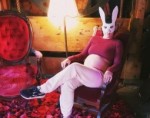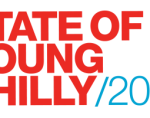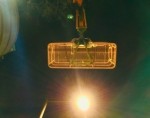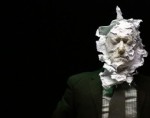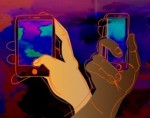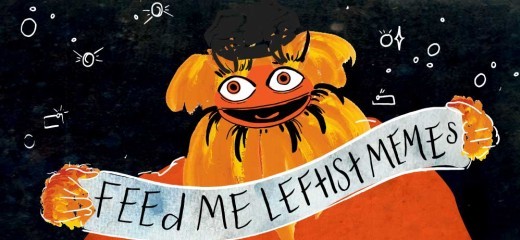
Gritty in Performance
by Mira Treatman
No sooner than the close of the annual Philadelphia Fringe Festival and the inevitable lull in activity that follows, Philadelphia’s arguably most significant performance of the year emerged. Gritty (no last name), the first Philadelphia Flyers mascot since 1976, was introduced to the ice hockey market in late September. Philadelphians and hockey fans met the new character with responses ranging from dubbing it “nightmare fuel” to mocking it as the result of the Flyers marketing department being desperate, underpaid, and on meth. Regardless of the critique and ridicule, or perhaps because of it, Gritty indisputably connected with people across many backgrounds as it rose to international viral fame.
Standing over seven feet tall in ice skates, clad in an orange Flyers uniform with matching fuzzy body hair and a bearded face only its mother could love, Gritty is the adorable and horrifying monster Philadelphia didn’t know it was missing. Its orange and black googly eyes are the inverted image of the Flyers logo—a hypnotic marketing ploy. Gritty’s signature moves—of unsexy pelvic thrusts, awkward shuffling, and top-heavy falls to the ice—rile up hockey fans in the Wells Fargo Center arena and on screens around the globe. Philadelphia’s Gritty is a new classic, the jawn of all jawns.
Gritty is a performer. It appears in discrete works, or even pieces, including on the Flyers opening night ceremony when it descended from the ceiling to Miley Cyrus’s “Wrecking Ball” on a chain. Gritty made it to the ice and then stood alone in the center of the rink, then performed several masculine swagger dance moves, such as smacking the chest, gesticulating like a stereotypical Italian mobster, and gesturing to rile up the crowd (to which they responded with hoots and hollers). These movements reflect a possible performance lineage with commedia dell’arte, the classical Italian form of comedy with a treasure trove of stock characters. I am beginning to see Gritty as one of the characters called Pulcinella, a “voice of the people.”
Gritty has undeniable masculinity and whiteness embedded in its performance. It is loud, fat, and obnoxious. It shakes its pelvis around as if performing some sort of sexy dance, but it just sloshes around its glutinous bloat. Its long orange beard and body hair have a striking resemblance to the yeti, a creature from the Global North. It dances like the most embarrassing dad at the youth ice hockey game in the stands, cheering for his kid, wobbling his beer gut around, moving in a big way, seizing attention with no concern for the repercussions. The way Gritty occupies space indicates its lack of concern for how it affects others and for its own personal safety. This is a privilege that can easily be pinpointed to white men.
Now a month into its life, Gritty’s viral presence took a political turn. When I first saw the appropriation of Gritty by artists and anti-fascist activists at a Trump protest, my breath was taken away. I was floored by some of the memes and art work created claiming Gritty as a worker and a part of the movements against the president and his supporters. In the weeks that followed the initial protest, Gritty has popped up in memes and political cartoons across the Internet as a symbol of resistance. I wonder if these artists have considered Gritty’s implied whiteness and masculinity in equating it with anti-fascist, socialist, and other progressive agendas.
Personally, I am more interested in how Gritty bridges “Old Philadelphia” with “New Philadelphia.” Taking Gritty at face value is a natural response from multi-generational Philadelphia sports fans, but relishing in the clown ironically while being a newcomer to the city holds a possible truth about the Mayor Kenney era. Gritty itself is an Old Philadelphian. Its name alone literally sends a post-industrial message; its namesake is the dirt, grime, and gumption of the former “Workshop of the World.” It is easy to imagine Gritty as a staunch pro-union, true blue Democrat. When transplants take glee in Gritty, I wonder if subconsciously they are taking out their possible guilt or discomfort with their daily interactions at the new-old borders. As a millennial born and raised in the city proper, I find myself bridging both worlds as I look to Gritty for a bit of levity.
The media has covered the Gritty story by treating this non-human mascot as a white man. Gritty’s clownish antics are disturbing and pointedly violent, but Gritty has been repeatedly left off the hook. In combing through national news sources and viral posts, I’ve seen Gritty’s poor (and yes, also hilarious) behavior blamed on it being psychotic, inbred, a drug addict under the El, a nightmare, someone’s white trash cousin from South Jersey, or just someone who has fallen on hard times. I see a striking similarity between this long list of excuses for Gritty with the way the media covers white men who commit gun violence and terrorism.
Yet, I am one of Gritty’s many unlikely fans. The only member of the Flyers I can tell you by name and number is Gritty, number 00. I have never stepped foot inside the Wells Fargo Center. All I know of ice hockey is that it’s vaguely from up north where there’s more ice than grass. Gritty serves as an analogue to the other big orange idiot that offers some kind of twisted catharsis. This, at the end of the day, is the most important task of performance.
The Philadelphia Flyers, Wells Fargo Center Philadelphia, October 4 - April 6.
By Mira Treatman
October 31, 2018



